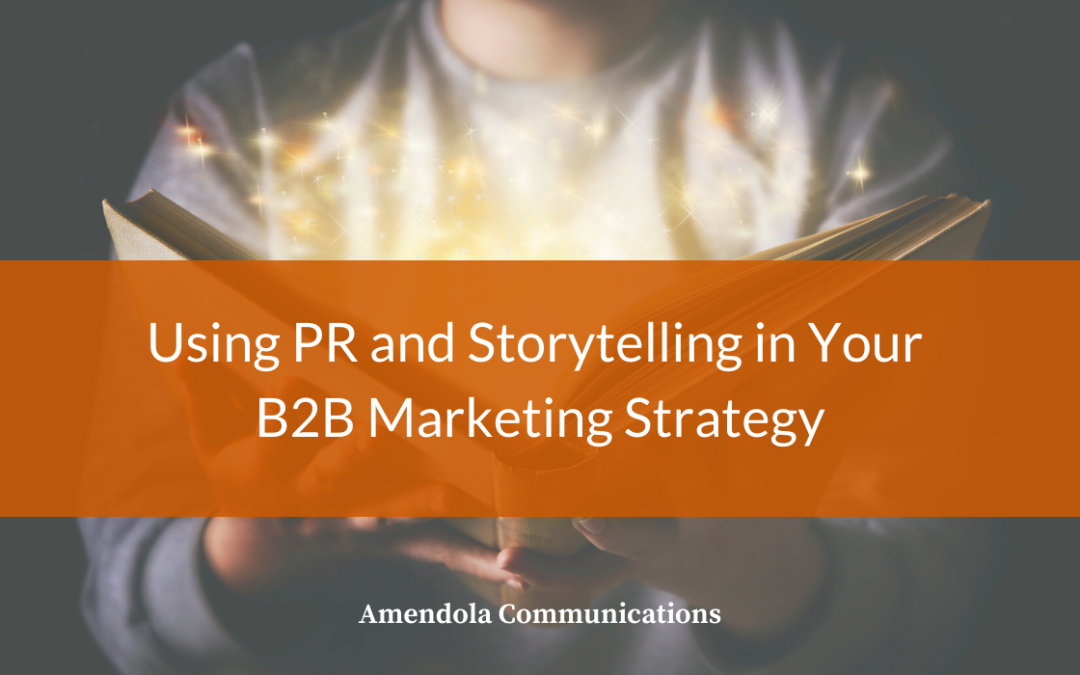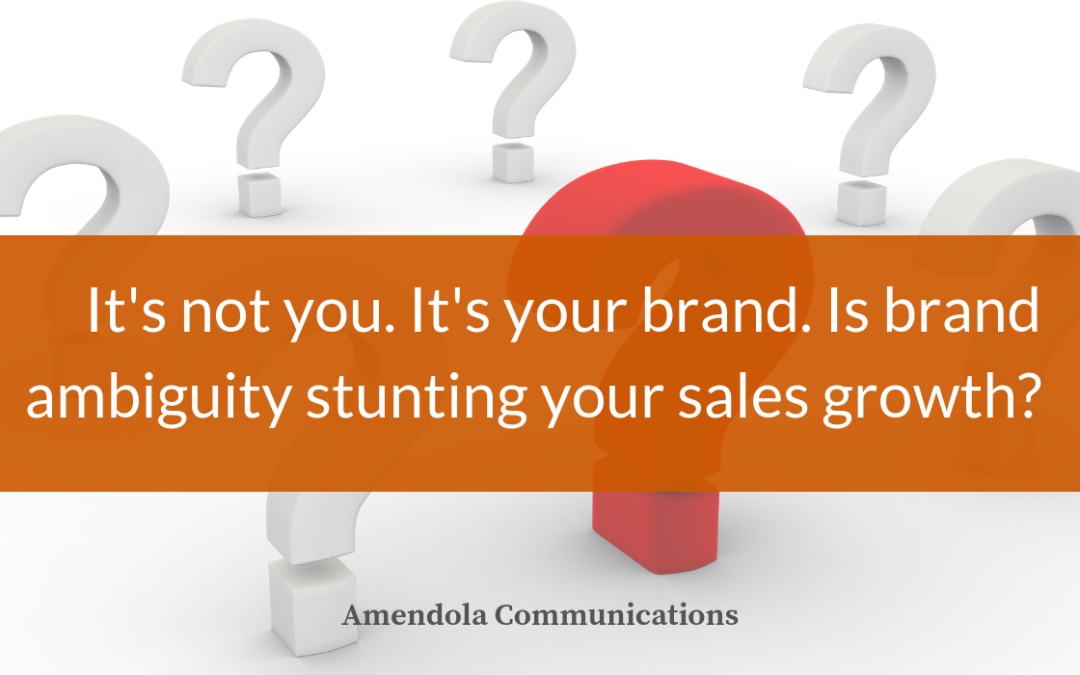
by Adam Beeson | Sep 1, 2021 | Blog
Are you talking at your customers, or are you speaking their language and partnering on their mission? This is a question that every marketer, communicator and sales team member should be asking regularly.
We all have some level of brand loyalty in our lives. For me, those brands are Nike, Honda, Jersey Mike’s, Apple, Aurora Health Care and The Wall Street Journal. My allegiance to those brands is based on quality, style, company mission, customer service, product consistency, availability and ethical business practices (there was a time when I liked Volkswagen – they ruined that).
But more importantly, those brands align with what I am striving to accomplish in my life as a father, husband, professional, coach, and member of society.
I’m sure you have a similar list of your own.
The same is true in the B2B space and we frequently see this in the vendor space. A simple example is the technology brands that a company buys for its employees. One business is an Apple buyer, another HP, and yet another swears by Lenovo. And yet computers can largely all run the same software – it’s the set up and components inside the devices that slightly differ. Logically when the devices can all do the same thing, this would seem like an ideal scenario to purchase based on price or recent quality achievements–but the B2B brand loyalty remains.
So how do you establish this level of brand loyalty with B2B customers? How can you be “sticky” when your competition is providing a very similar product?
You need to be more than a vendor. You need to demonstrate that you are an ally on their mission.
Let’s consider a healthcare technology vendor – pick one, there are plenty. They’re solving for the difficult problems in healthcare, like access to mental health services, providing telehealth services, building an improved billing platform, managing opioid prescribing, simplifying decentralized clinical trials….and the list goes on. And this is what their team concentrates on every single day.
But you know what? These solutions are only a small piece of what healthcare providers are concentrating on. The industry has three or four vendor competitors solving for the same problem. And they all tout similar features, such as integrations with big EHR providers like Epic and Cerner. As much as the tech vendor is going to point to a certain feature or new rating, the healthcare provider would rather move on to bigger issues.
And that’s where the opportunity lies: the customer’s bigger mission.
Newsflash – every healthcare provider has a similar objective and a mission statement along the lines of: ‘provide healthcare services that help individuals, families, and communities live longer and healthier lives.’
Now, if you want to be the healthcare provider’s long-term partner or ally, guess what they want you to help them accomplish? Hint: it’s not just integration with an EHR or tracking how many opioids have been prescribed.
If you want to be a provider’s valued partner, you must demonstrate how your solution will help them achieve their mission of saving lives and creating healthier populations.
If your solution is designed to solve for challenges in the mental health space, for example, an everyday vendor will demonstrate how their solution tracks a patient through their care and identifies patients at risk for pharmaceutical addiction.
But a valued partner is going to do those things, plus help track patients as they navigate multiple care providers and the justice system. The valued partner will demonstrate how their solution is improving care adoption for patients battling anxiety and depression. The ultimate outcome of a valued partner’s relationship will focus on improved community care statistics, decreasing arrest rates, and an overall healthier community.
As a health IT vendor seeking to align with a healthcare provider, communicating your story is critical and requires distinguishing yourself and your offering as a partner:
- Create a core narrative that explains how your brand is advancing overall industry mission priorities. Use this content internally and externally to drive your brand message. Refine and update this message on a quarterly basis.
- Leverage your core narrative to create thought leadership content. These new pieces of content can be leveraged in the press, distributed through your marketing nurture campaigns, posted as core blog content, drive your social media efforts, and sales teams can share this content widely with prospects and clients.
- Empower a leader as the owner of your vision for the industry mission. This person, or people, should be named as the author of your content. Further, leverage your PR agency to establish these leaders as a valued interview with industry reporters and then make them easily accessible to the press.
- Engage with your customers and tell their story as examples of how your efforts are advancing industry change and helping to accomplish their missions.
- Survey customers and prospects to better understand their priorities, and where they stand on efforts to move their business mission forward. Share survey data publicly to help the industry define next steps. Leverage this new business intelligence to engage with customers and prospects on how your products can help to achieve their mission.
- During regular meetings, ask clients where they stand on their mission priorities and how your solution can further help with those efforts. Provide insights on additional opportunities from your perspective. And then follow through.
Each of these key steps will redefine your brand and drive brand loyalty from your clients and your prospects. More importantly, this repeated process will allow you to demonstrate your commitment to being the company’s valued partner, time and time again. You will have aligned with their mission, demonstrated the success, and publicly committed to one another’s future success.

by admin | Mar 11, 2020 | Blog
Your company has a story and people want to hear it.
Remember the last time you heard a great story? If you’re anything like me, it was probably a movie or T.V. show. Since the entertainment industry makes money by telling good stories, this makes sense. But in our fast-paced, tech-driven society, we rely on text messaging (guilty!), email and IMs and we don’t take the time to tell stories like we used to.
In the Don Draper, Mad Men, days of advertising storytelling was relatively simple. Come up with a catchy phrase and call it day. Now that we are bombarded with marketing campaigns on a 24×7 basis, it is harder to cut through the clutter.
That’s where storytelling and public relations come in. But what does it take to tell a really good story? Especially in a B2B environment?
Not too long ago, I was asked by my marketing team to think about a B2B brand that really made an impression on me. Of course, my first reaction was come on. B2B + engaging content = doesn’t add up!
But then I thought about it and remembered a simple phrase that a sales representative from Wrike told me, “what you need is a single source of truth.”
If you aren’t familiar with Wrike, it’s a project management platform that can be shared across teams and business. It really can be that one source of truth rather than combing through endless emails to find that one URL or status update that you might have accidentally deleted because you tried to check your work email on your phone while at happy hour (I’ve only heard via storytelling that these things can happen!).
That phrase single source of truth will never leave my brain. Because it is precisely what my brain needed to hear to solve my need for organizing information.
Now I am an unofficial brand ambassador for this company. And that is the power of knowing your brand’s story.
At the end of the day, your story shouldn’t be about you at all. It should be about the things that matter to your buyer personas, but it should also be personal. (Yes, even B2B can be personal; we’re still humans in the work environment).
Never underestimate the value of making an emotional connection in the B2B world especially in healthcare. With health IT becoming more and more saturated, the B2B landscape is changing and it’s becoming more critical for strong B2B brands to do what strong brands do around the world engender trust and reduce perceived risk.
We have critical problems to fix in healthcare and every single client I work with creates technology that betters the lives of so many patients, physicians, nurses, payers the list could go on for days. But sometimes getting to the root of how this technology is shifting the healthcare environment is challenging.
Successful public relations activities rely on being able to tell powerful and insightful stories. Storytelling is an important aspect to public relations strategies because it allows companies to better connect with their audience.
Here are four ways your B2B brand can become a good storyteller.
1. Start with a broad narrative that helps tell the story of your company.
Purpose is essential to a strong corporate culture and it is often activated and reinforced through narrative. Individuals must learn to connect their drives to the organization’s purpose and to articulate their story to others.
A professor at Harvard University developed a simple framework for those hoping to develop a narrative approach to their purpose-driven organizations: “Self, Us, Now.” “Self” looks at the real-life events of the leader or leaders that created a company it helps to establish the values that will ultimately become the values of the organization.
“Us” aims to connect those values with broader shared values of your audiences or stakeholders, e.g., clients or employees. By weaving these personal narratives into the narratives of others, you create a common narrative for the group or organization.
And finally, “now” is the urgent call to action for those who wish to achieve the same purpose as your organization.
2. Consolidate your narrative into an elevator pitch.
Now that you’ve develop what I like to call the soul of your company, it’s likely a lengthy narrative as it should be since your company is solving some of healthcare’s most complex challenges. The elevator should pull out some of those key emotion-grabbing narratives and concisely explain:
- Who are you?
- What do you offer?
- What problem do you solve?
- How are you different (unique selling proposition)?
- Your call to action
3. Adapt your elevator pitch into something that could be used as an “About Us.”
Now that you have a well-developed narrative that explains your unique identity, craft your story! Evoke an emotional response in your buyer persona. Provide a simple and clear value proposition, establish your credibility, and give a call to action. As they say, the best way to sell something is to not sell anything. Earn trust and loyalty by telling a compelling story to help stick in your customer’s mind.
4. Frame up your narrative against core themes that can represent your overall business.
Likely you’ve got a lot of products but talking about each product separately can quickly become overwhelming. If it’s overwhelming for your marketing team, then it is overwhelming for your customers too. Work to identify the core themes that your products can be categorized into. Then tell how those themes are solving our most critical problems.
Storytelling can’t be mastered overnight. It takes practice but it is worth it as there is nothing more powerful than making your content and news relatable to your audience. Tell good tales, and you’ll quickly find your audience will see you as a true thought leader and they will come to you.

by Jenn Cohen | May 1, 2019 | Blog
Over the last fifteen years, I’ve participated in more corporate messaging workshops than can be counted. Inevitably, at a certain point during the workshop, the facilitator will ask the collective group: “Who ARE we?” Typically, the marketing leaders are quick to reiterate the company’s vision or mission statement, while sales leaders rattle verbiage from their elevator pitches, and executives state messages similar to those they give investors on analyst calls. Turns out, answering “Who ARE we?” is not that simple of a question after all.
Is your brand suffering from a bit of ambiguity? Try this simple experiment the next time you’re riding up the elevator with colleagues. Ask the folks standing beside you, “Who is {insert your company name here}?”
I’m not a gambler, but I’d wage a bet you’d get limited overlap in responses. Why? Perhaps because your organization hasn’t fully invested the time and effort into crystalizing their brand positioning and brand purpose for all employees, customers and stakeholders.
No longer reserved for consumer-facing brands, it has become essential for business-to-business organizations to not only create and develop a brand but also define their position and purpose. Why?
Not only will it separate your brand from a sea of sameness among competition, but it can elevate your position in the market. If we as marketers can prevent our sales team from being asked “So who are you, again?” we’ve done part of our job.
I’ve worked on branding and rebranding initiatives for companies of all sizes and what do they all have in common? An aligned purpose to create a great brand.
But what does it take to go from good to great? Well, good brands merely fulfill a need. They provide a service, or a product, based upon an expressed need.
But a great brand? A great brand anticipates. How? By truly understanding their customers. Talking to them. Asking questions. Reading about them in the news. Thinking about their current and future needs.
And while it may be unpleasant, or downright excruciating, asking your customers where your brand falls short can be one of the first steps towards creating a brand people trust. After all, people want partners, not vendors.
Sometimes the most important part of creating and maintaining a successful brand is simply realizing that just because something isn’t broken doesn’t mean it’s working. In the last year alone, we’ve seen notable brands take inventory of their brand presence and come to the ultimate realization that their current identity is no longer aligned with their future state. Let’s look at three notable examples:
Dunkin Donuts ditched the donuts and debuted a short name Dunkin along with a modernized look and feel to test stores around the country earlier this year. The company is investing $100 million to update their stores and “better meet the evolving tastes” of their customers, which will include new equipment and dedicated drive-through lanes so people who order drinks on their phones (hello, Starbucks!) can pick them up easily. They realized the market demanded more than coffee and donuts to stay competitive, and they’re putting their money where their mouth is.
Unlike Dunkin’, Slack kept their name but instead chose to revamp their original (dare I say iconic?)logo. This move caused an onset of conversation around the decision to ditch the beloved hashtag in favor of a simpler visual identity. Why? They felt it was time to evolve. Beyond the unexpected logo swap, Slack’s rebrand came in advance of a direct public offering expected later this year.
Earlier this year, WeWork announced their rebrand, informing the market that they will now be known as We Company. This strategy was likely designed for both investors and customers in order to broaden their aspirations from places to people. The announcement also came with a sweet perk to the tune of $2 billion in investment from SoftBank Group.
Taking inventory of your current brand and determining whether it aligns with your future growth is no easy feat. In part two of this post, we’ll review the main drivers that help indicate when a logo refresh is needed, a repositioning workshop will do, or when a full rebrand makes the most sense.
We’ll walk through logical next steps, including how to get it done. Using your brand as a springboard to add colorful depth to your offerings can easily change the conversation and help your sales team create meaningful relationships to not just power the sales cycle but build the funnel at the same time.



